Deflection Routing in an All-Optical Network in 2D Grid Performance Evaluation
- 格式:pdf
- 大小:175.30 KB
- 文档页数:25
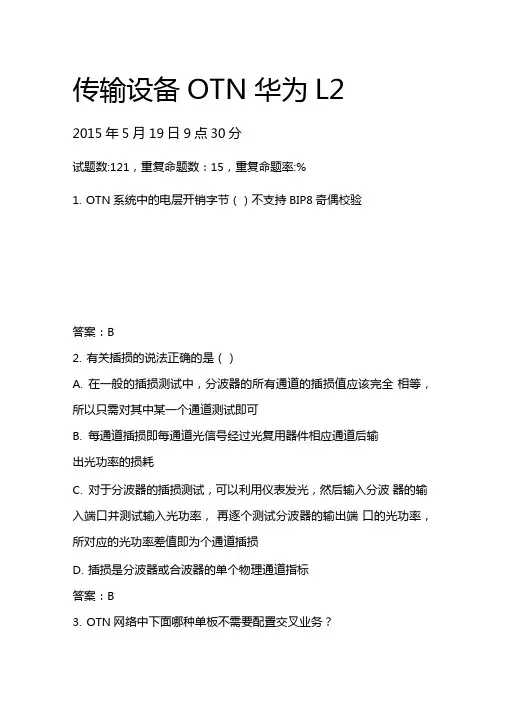
传输设备OTN华为L22015年5月19日9点30分试题数:121,重复命题数:15,重复命题率:%1.OTN系统中的电层开销字节()不支持BIP8奇偶校验答案:B2.有关插损的说法正确的是()A.在一般的插损测试中,分波器的所有通道的插损值应该完全相等,所以只需对其中某一个通道测试即可B.每通道插损即每通道光信号经过光复用器件相应通道后输出光功率的损耗C.对于分波器的插损测试,可以利用仪表发光,然后输入分波器的输入端口并测试输入光功率,再逐个测试分波器的输出端口的光功率,所对应的光功率差值即为个通道插损D.插损是分波器或合波器的单个物理通道指标答案:B3.OTN网络中下面哪种单板不需要配置交叉业务?答案:A4.主控板上液晶指示灯显示” 1表示该子架为:()A.从子架2B.从子架1C.主子架D.从子架3答案:B5.子网连接保护(SNCP)不包括:()SNCP保护B.客户侧1+1保护SNCP保护SNCP保护答案:B6.某网络出现大面积无规律的网元脱管,下面原因中最有可能的原因A.网元NCP故障B.网管到网元的路由不稳定C.网管运行故障D.网管数据库故障答案:B7.以下说法正确的是()上设置15分钟监视开始时间(必须晚于网管和网元的当前时间)。
分钟监视结束时间(必须晚于15分钟监视开始时间),必须设置上设置15分钟监视开始时间(可以早于于网管和网元的当前时间)。
分钟监视结束时间(必须早于15分钟监视开始时间),可以不设置。
答案:A8.波长的OTU单板,其输出接在M40的第()口。
答案:B9.管线资源系统中,光缆与光缆段是A. -- 对应关系B.从属关系C.归属关系D.无关系答案:A10.()是在两个光交接设备光交光分终端盒)之间的直达光纤,包含熔接点,即光纤路由A.光路B.管道段C.局向光纤D.挂墙段答案:C重复命题1次11.DWDM系统中,实现波长转换的关键器件是()答案:D12.OTN规定OCH的三个子层的关系,从客户侧输入到波分侧输出正确的是A.客户业务一>OPU「>ODU—>OTUkB.客户业务一>ODU—>OPUk->OTUkC.客户业务一>OPUk - >OTUk->ODUkD.客户业务一>OTU—>ODU—>OPUk答案:A13.PTN采用24位来标志网元ID,其中高8位是(),低16位是(:「其中()的彳作用是用来标识一个区域内的PTN 网元A.基础ID,扩展ID,基础IDB.扩展ID,基础ID,扩展IDC.基础ID,扩展ID,扩展ID ;D.扩展ID,基础ID,基础ID答案:B14.某单板面板上的条形编码最后几位是TN1M1LOG01TPT,对其含义描述正确的是()。
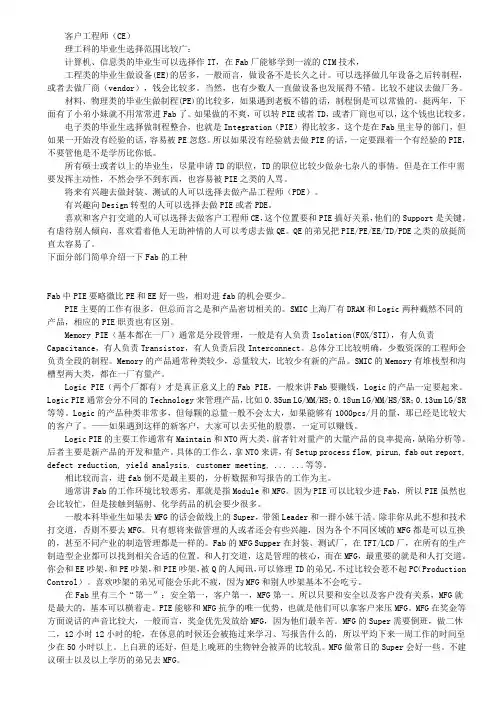
客户工程师(CE)理工科的毕业生选择范围比较广:计算机、信息类的毕业生可以选择作IT,在Fab厂能够学到一流的CIM技术,工程类的毕业生做设备(EE)的居多,一般而言,做设备不是长久之计。
可以选择做几年设备之后转制程,或者去做厂商(vendor),钱会比较多。
当然,也有少数人一直做设备也发展得不错。
比较不建议去做厂务。
材料、物理类的毕业生做制程(PE)的比较多,如果遇到老板不错的话,制程倒是可以常做的,挺两年,下面有了小弟小妹就不用常常进Fab了。
如果做的不爽,可以转PIE或者TD,或者厂商也可以,这个钱也比较多。
电子类的毕业生选择做制程整合,也就是Integration(PIE)得比较多,这个是在Fab里主导的部门,但如果一开始没有经验的话,容易被PE忽悠。
所以如果没有经验就去做PIE的话,一定要跟着一个有经验的PIE,不要管他是不是学历比你低。
所有硕士或者以上的毕业生,尽量申请TD的职位,TD的职位比较少做杂七杂八的事情。
但是在工作中需要发挥主动性,不然会学不到东西,也容易被PIE之类的人骂。
将来有兴趣去做封装、测试的人可以选择去做产品工程师(PDE)。
有兴趣向Design转型的人可以选择去做PIE或者PDE。
喜欢和客户打交道的人可以选择去做客户工程师CE,这个位置要和PIE搞好关系,他们的Support是关键。
有虐待别人倾向,喜欢看着他人无助神情的人可以考虑去做QE。
QE的弟兄把PIE/PE/EE/TD/PDE之类的放挺简直太容易了。
下面分部门简单介绍一下Fab的工种Fab中PIE要略微比PE和EE好一些,相对进fab的机会要少。
PIE主要的工作有很多,但总而言之是和产品密切相关的。
SMIC上海厂有DRAM和Logic两种截然不同的产品,相应的PIE职责也有区别。
Memory PIE(基本都在一厂)通常是分段管理,一般是有人负责Isolation(FOX/STI),有人负责Capacitance,有人负责Transistor,有人负责后段Interconnect。
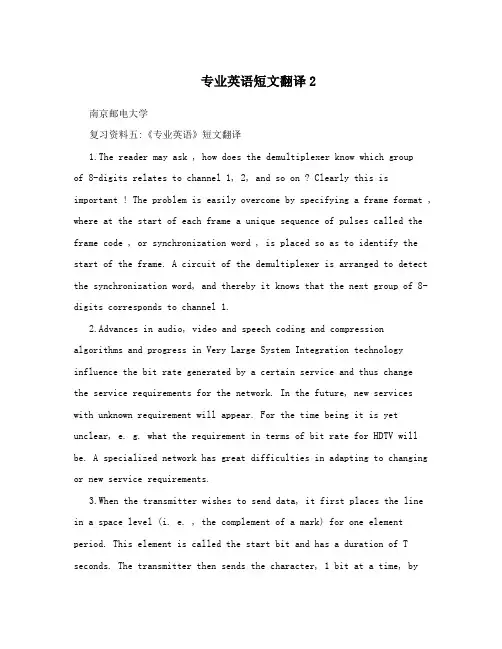
专业英语短文翻译2南京邮电大学复习资料五:《专业英语》短文翻译1.The reader may ask , how does the demultiplexer know which groupof 8-digits relates to channel 1, 2, and so on ? Clearly this is important ! The problem is easily overcome by specifying a frame format , where at the start of each frame a unique sequence of pulses called the frame code , or synchronization word , is placed so as to identify the start of the frame. A circuit of the demultiplexer is arranged to detect the synchronization word, and thereby it knows that the next group of 8-digits corresponds to channel 1.2.Advances in audio, video and speech coding and compression algorithms and progress in Very Large System Integration technology influence the bit rate generated by a certain service and thus changethe service requirements for the network. In the future, new services with unknown requirement will appear. For the time being it is yet unclear, e. g. what the requirement in terms of bit rate for HDTV will be. A specialized network has great difficulties in adapting to changing or new service requirements.3.When the transmitter wishes to send data, it first places the line in a space level (i. e. , the complement of a mark) for one element period. This element is called the start bit and has a duration of T seconds. The transmitter then sends the character, 1 bit at a time, byplacing each successive bit on the line for a duration of T seconds, until all bits have been transmitted. Then a single parity bit is calculated by the transmitter and sent after the data bits. Finally, the transmitter sends a stop bit at a mark level (i. e. the same level as the idle state) for one or two bit periods. Now the transmitter may send another character whenever it wishes4.The cellular switch, which can be either analog or digital, switches calls to connect mobile subscribers to other mobile subscribers and to the nationwide telephone network.. It also contains data links providing supervision links between the processor and the switch and between the cell sites and the processor. The radio link carries the voice and signaling between the mobile unit and the cell site. Microwave radio links or wire lines carry both voice and data between the cellsite and the MTSO.5.Today's telecommunication networks are characterized by specialization . This means that for every individual telecommunication service at least one network exists that transports this service. A few examples of existing public networks are described below Computer data are transported in the public domain by a packet switched data network (PSDN) based on X.25 protocol6.Today’s telecommunication networks are characterized by specialization . This means that for every individual telecommunication service at least one network exists that transports this service. A few examples of existing public networks are described below:Computer data are transported in the public domain by a packet switched data network (PSDN) based on X.25 protocols.Television signals can be transported in three ways: broadcast via radio waves using ground antenna, by the coaxial tree network of the community antenna TV (CATV) network or recently via a satellite, using the so-called direct broadcast system (DBS)7.By far the most popular serial interface between a computer andits CRT (显示器) terminal isthe asynchronous serial interface . This interface is so called because the transmitted data and the received data are not synchronized over any extended period and therefore no special means of synchronizing the clocks at the transmitter and receiver is necessary. In fact, the asynchronous serial data link is a very old form of data transmission system and has its origin in the era of the第1页共4页南京邮电大学teleprinter.8.At the receiving end of an asynchronous serial data link, the receiver continually monitors the line looking for a start bit. Once the start bit has been detected, the receiver waits until the end of thestart bit and then samples the next N bits at their centers, using a clock generated locally by the receiver. As each incoming bit is sampled, it is used to construct a new character. When the received character has been assembled, its parity is calculated and compared with the receivedparity bit following the character. If they are not equal, a parityerror flag is set to indicate a transmission error.9.If we consider binary transmission , the complete informationabout a particular message will always be obtained by simply detecting the presence or absence of the pulse. By comparison, most other forms of transmission systems convey the message information using the shape , or level of the transmitted signal ; parameters are most easily affected by the noise and attenuation introduced by the transmission path . Consequently there is an inherent advantage for overcoming noisy environments by choosing digital transmission.10. The Internet is the largest repository of information which can provide very large network resources . The network resources can be divided into network facilities resources and network information resources . The network facilities resources provide us the ability of remote computation and communication . The network information resources provide us all kinds of information services , such as science , education , business , history , law , art , and , entertainment , etc11.The SDH standards are based on the principle of direct synchronous multiplexing which is the key to cost effective and flexible telecommunication networking. In essence, it means that individual tributary signals may be multiplexing directly into a higher rate SDH signal without intermediate stage of multiplexing. SDH Network Elements can then be interconnected directly with obvious cost and equipment savings over the existing network.12.Improvements in component performance, cost, and reliability by 1980 led to major commitments on the part of telephone companies. Fibre soon became the preferred transmission medium for long-haul trunks. Some early installations 0. 8 µm light sources and graded-index multimode fibre, but by 1983, designers of intercity links were thinking in terms of 1. 3 µm, single-mode systems. The single-mode fibere, used in conjunction with a 1. 3 µm laser, provides a bandwidth advantage which translates into increased repeater spacings for high data rate system.13.The individual elements of multimedia are already handled by a standard 486 personal computer, such things as audio, graphics and text, but the major challenge is in real time video, for this is the major business requirement and a necessity if multimedia systems are to become standard items for the desktop. This real time processing requires a vast amount of data storage and this is a function of the amount of information contained in a colour picture, for instance a normal640×480pixel colour picture requires well over 1 M bytes of storage to give the required quality, though for full motion video this is increased up to 100 M bytes of data.1.读者也许会问,解复用器怎么知道哪一组8位码对应于第一路、第二路及其他各路呢?显然这是很重要的。
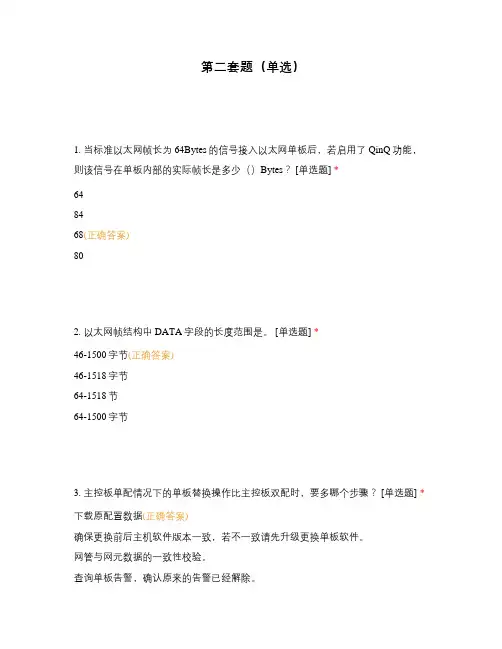
第二套题(单选)1. 当标准以太网帧长为64Bytes的信号接入以太网单板后,若启用了QinQ功能,则该信号在单板内部的实际帧长是多少()Bytes? [单选题] *648468(正确答案)802. 以太网帧结构中DATA字段的长度范围是。
[单选题] *46-1500字节(正确答案)46-1518字节64-1518节64-1500字节3. 主控板单配情况下的单板替换操作比主控板双配时,要多哪个步骤? [单选题] *下载原配置数据(正确答案)确保更换前后主机软件版本一致,若不一致请先升级更换单板软件。
网管与网元数据的一致性校验。
查询单板告警,确认原来的告警已经解除。
4. 以下关于MPLS-TP OAM层次的说法,正确的是: [单选题] *Section是Tunnel的服务层,Tunnel是PW的服务层,PW是Service的服务层(正确答案)Section是PW的服务层,PW是Tunnel的服务层,Tunel是Service的服务层Service是PW的服务层,PW是Tunnel的服务层,Tunnel是Section的服务层Tunnel是PW的服务层,PW是Service的服务层,Service是Section的服务层5. 以下关于以太网单板的内部端口属性的描述,错误的是: [单选题] *A. 对Access属性的入端口。
如果输入数据带有VLAN ID,丢弃对Tag Aware属性的入端口,如果输入数据带有VLAN ID,透传接收数据(正确答案)对Access属性的入端口,如果输入数据不带VLAN ID,直接透传对Tag Aware属性的入端口,如果输入数据不带VLAN ID,丢弃6. 以下哪项SOM系统监控不到。
[单选题] *主光路性能发端FEC的类型(正确答案)光性能平坦度收端OTU输入光功率7. 告警反转的设置是基于: [单选题] *A. 单板网元端口(正确答案)告警8. 在网管上查询误码及光功率之前需要进行()操作,否则无法查询相应教据。
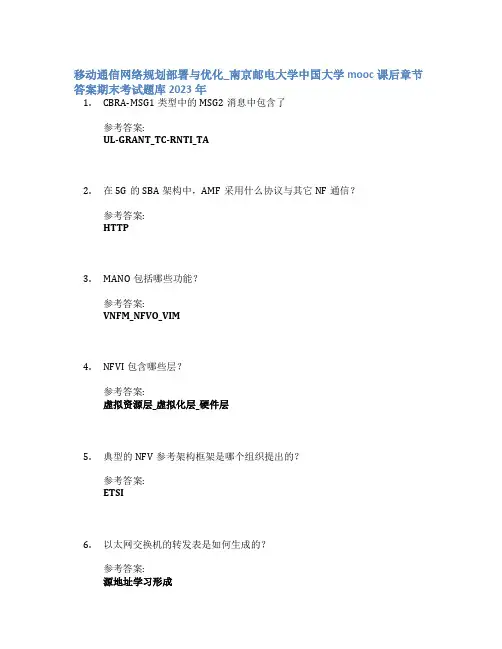
移动通信网络规划部署与优化_南京邮电大学中国大学mooc课后章节答案期末考试题库2023年1.CBRA-MSG1类型中的MSG2消息中包含了参考答案:UL-GRANT_TC-RNTI_TA2.在5G的SBA架构中,AMF采用什么协议与其它NF通信?参考答案:HTTP3.MANO包括哪些功能?参考答案:VNFM_NFVO_VIM4.NFVI包含哪些层?参考答案:虚拟资源层_虚拟化层_硬件层5.典型的NFV参考架构框架是哪个组织提出的?参考答案:ETSI6.以太网交换机的转发表是如何生成的?参考答案:源地址学习形成7.AMF配置的到NRF的路由中,掩码是以下哪个?参考答案:255.255.255.2558.当以太网交换机收到目的地址为C的帧,但是其转发表中无对应表项,那么它如何操作?参考答案:向所有其他端口转发9.如何分割广播域?参考答案:使用VLAN技术10.交换机向Acess端口发帧时,将报文的VLAN信息剥离,直接发送出去。
参考答案:正确11.交换机从 trunk端口收到一个帧时,并发现该帧中包含VLAN信息,且本trunk端口不允许该 VLAN的数据进入。
则丢弃该帧。
参考答案:正确12.AMF和CUCP之间要配置以下哪个接口的对接数据?参考答案:N213.核心网:UDM需要规划Loopback地址。
参考答案:错误14.在5G核心网的设备配置中,交换机SW采用以下哪种线缆连接服务器?参考答案:成对LC-LC光纤15.5G承载网一般分为三个层次:()、()、()。
参考答案:核心层16.路由器根据什么地址来实现数据的转发?参考答案:IP地址17.全局同步栅格以ARFCN指定了所有频率的位置参考答案:正确18.路由器工作在OSI参考模型的第几层?参考答案:第三层19.核心网:光纤两端接口的速率应一致参考答案:正确20.每个运营波段有不同的GSCN取值范围和步长。
参考答案:正确21.以下哪个网元不属于5G的SBA架构?参考答案:MME22.在5G的SBA架构中,每个NF是通过哪个网元发现其它NF提供的服务的?参考答案:NRF23.在5G的SBA架构中,每个NF并不是点对点连接。
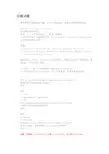
后端试题1.老是简单的问题比较无趣,问一个貌似简单,但是不容易回答完整的How to fix x-talk violation?如何解决线间干扰?难度:4 (关于难度的定义,在第一题里面)(应该至少有5大类解决办法,wire spacing, shielding, change layer 之类的只算其中1类)答案:1)upsize victim net driver, downsize aggressor net driver2)increase wire space, shielding, change layer,change wire width 3)insert butter in victim net能答出以上3条的,在工作中已经基本够用,但是还有两个不常用到的,是AMD的一个大牛告诉我的。
4)把与victim net相连的输入端改成Hi-Vth的单元5)改变信号的timing window。
这个不易做到,但是也是解决方法2.What are several factors to improve propagation delay of standard cell?哪些因素可以影响标准单元的延迟?难度:3答案:1)PVT2)input transition,output load3)Vth3.What would you do in order to not use certain cells from the library?如何禁止使用库里面的某些单元?难度:1答案:set_dont_useset_dont_touch4.During the synthesis, what type of wire load model are often used?做RTL综合时,经常使用的wire load model有哪几种?难度:2注意:问题是wire load model,不是wire load mode,也不是delay model1)zero wire load model2)基于fanout的传统WLM3)基于物理位置(距离)的wire load model,在Cadence的RC中叫PLE,Synopsys 叫DC Ultra Topographical附加问题:What types of delay model are used in digital design? (数字IC设计中有多少种类型的delay model)答案:NLDMCCSECSM还有一个现在基本不用了的—LDM5.How delays are characterized using WLM (Wire Load Model)?使用一般的WLM (不是zero WLM,也不是按照物理位置算的DCT),DC是如何计算delay的?难度:2答案:DC在计算延时的时候,net的rc就要根据所选取的wrie load model来计算,计算时和输出的fanout决定以smic13的smic13_wl10为例wire_load("smic13_wl10") {resistance : 8.5e-8;capacitance : 1.5e-4;area : 0.7;slope : 66.667;fanout_length (1,66.667);根据fanout值,由fanout(1,66.667)可以得出互连线长度为66.667,然后根据resistance 和capacitance计算出互连线电容为1.5e-4*66.667,互连线电阻为8.5e-8*66.667,当然如果扇出值表中没有,就会用到slope,例如扇出为3时,此时估算的互连线长度为1*66.667+(3-1)*slope,再计算出RC值,然后DC由此计算net的延时。
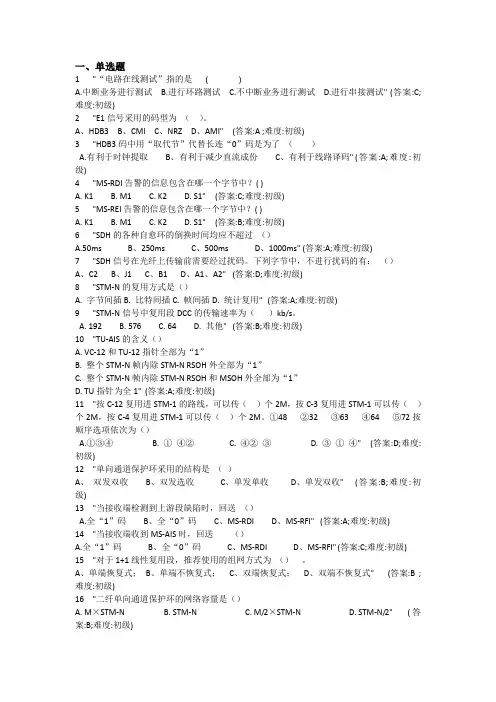
一、单选题1 "“电路在线测试”指的是( )A.中断业务进行测试B.进行环路测试C.不中断业务进行测试D.进行串接测试" (答案:C;难度:初级)2 "E1信号采用的码型为()。
A、HDB3B、CMIC、NRZD、AMI" (答案:A ;难度:初级)3 "HDB3码中用“取代节”代替长连“0”码是为了()A.有利于时钟提取B、有利于减少直流成份C、有利于线路译码" (答案:A;难度:初级)4 "MS-RDI告警的信息包含在哪一个字节中?( )A. K1B. M1C. K2D. S1" (答案:C;难度:初级)5 "MS-REI告警的信息包含在哪一个字节中?( )A. K1B. M1C. K2D. S1" (答案:B;难度:初级)6 "SDH的各种自愈环的倒换时间均应不超过()A.50ms B、250ms C、500ms D、1000ms" (答案:A;难度:初级)7 "SDH信号在光纤上传输前需要经过扰码。
下列字节中,不进行扰码的有:()A、C2B、J1C、B1D、A1、A2" (答案:D;难度:初级)8 "STM-N的复用方式是()A. 字节间插B. 比特间插C. 帧间插D. 统计复用" (答案:A;难度:初级)9 "STM-N信号中复用段DCC的传输速率为()kb/s。
A. 192B. 576C. 64D. 其他" (答案:B;难度:初级)10 "TU-AIS的含义()A. VC-12和TU-12指针全部为“1”B. 整个STM-N帧内除STM-N RSOH外全部为“1”C. 整个STM-N帧内除STM-N RSOH和MSOH外全部为“1”D. TU指针为全1" (答案:A;难度:初级)11 "按C-12复用进STM-1的路线,可以传()个2M,按C-3复用进STM-1可以传()个2M,按C-4复用进STM-1可以传()个2M。
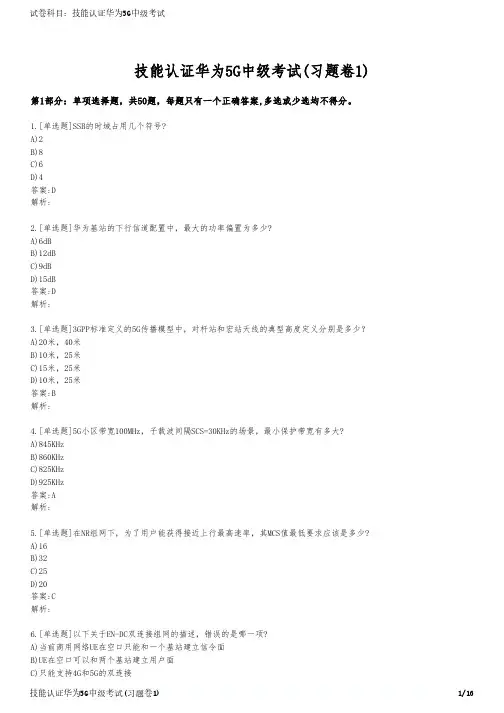
技能认证华为5G中级考试(习题卷1)第1部分:单项选择题,共50题,每题只有一个正确答案,多选或少选均不得分。
1.[单选题]SSB的时域占用几个符号?A)2B)8C)6D)4答案:D解析:2.[单选题]华为基站的下行信道配置中,最大的功率偏置为多少?A)6dBB)12dBC)9dBD)15dB答案:D解析:3.[单选题]3GPP标准定义的5G传播模型中,对杆站和宏站天线的典型高度定义分别是多少?A)20米,40米B)10米,25米C)15米,25米D)10米,25米答案:B解析:4.[单选题]5G小区带宽100MHz,子载波间隔SCS=30KHz的场景,最小保护带宽有多大?A)845KHzB)860KHzC)825KHzD)925KHz答案:A解析:5.[单选题]在NR组网下,为了用户能获得接近上行最高速率,其MCS值最低要求应该是多少?A)16B)32C)25D)20答案:C解析:6.[单选题]以下关于EN-DC双连接组网的描述,错误的是哪一项?D)信令面建立在5G侧答案:D解析:7.[单选题]以下哪项是DFT-S-OFDM波形特有的物理层处理步骤A)ModulationB)layermappingC)transformprecodingD)scrambling答案:C解析:8.[单选题]5G小区带宽100MHz,子载波间隔SCS=30KHz的场景,最小保护带宽有多大?A)860KHzB)825KHzC)925KHzD)845KHz答案:D解析:9.[单选题]在切换准备过程中,源小区基于以下哪个参数确定切换的目标小区?A)PCIB)NCGIC)TACD)频点答案:A解析:10.[单选题]以下那个标识用户在AMF内部唯一标识一个用户?A)5G-GUTIB)5G-TMSIC)GUAMID)5G-S-TMSI答案:A解析:11.[单选题]PDSCHDMRS和TRS之间使用哪种类型的QCLA)TypeBB)TypeAC)TypeCD)TypeD答案:B解析:12.[单选题]5G RAN2.1 64T64R的AAU可以最多支持多少种广播波束场景配置?A)17B)3C)813.[单选题]N.R下行带宽100Mhz使用SCS为30KHz时,每个RBG包含多少个PRB?A)16B)8C)2D)4答案:A解析:14.[单选题]TU对于5mMC业务要求的连接能力是多少?A)百万终端小区B)十万终端平方公里C)十万终端/小区D)百万终端+平方公里答案:D解析:15.[单选题]当前版本支持Option3和Option3x两种架构,具体使用何种架构是在以下哪个网元进行配置的?A)gNodeBB)SGWC)MMED)eNodeB答案:B解析:16.[单选题]NSA组网下NR的QoS配置信息可能包含在哪些消息中?A)SgNB Change RequiredB)SgNB Modification RequiredC)SgNB Addition RequestD)SgNB Modification Request答案:B解析:17.[单选题]以下哪一项属于测量对象NRCELL的指标?A)MAC层指标B)PRB类指标C)RLC层指标D)PDCP层指标答案:B解析:18.[单选题]以下哪一个事件用于基于频率优先级的异频切换触发环节?A)A2事件B)A5事件C)A1事件D)B1事件答案:C解析:B)SgNB Modification RequiredC)SgNB Addition Request Acknow ledgeD)SgNB Change Required答案:C解析:20.[单选题]S.A组网场景下,服务小区的重选参数是在哪个系统消息下发的A)SIB3B)SIB2C)SIB4D)SIB1答案:B解析:21.[单选题]某个小区SSB波束采用默认模式,天线挂高35米,机械下倾角为3°,数字下倾配置为0°,则此小区主覆盖波瓣的下沿(近点)距离基站约是多少米?A)150米B)330米C)1200米D)670米答案:B解析:22.[单选题]当子载波带宽为60kHz时,每帧包含多少个时隙?A)10B)80C)20D)40答案:D解析:23.[单选题]以下关于PDSCH DMRS的配置方案中,哪种方案的开销是最大的?A)Type2 前置单符号B)Type1 前置单符号C)Type2 前置双符号D)Type1 前置双符号答案:C解析:24.[单选题]在低频场景下,UE是如何获取当前SSB的波束ID?A)通过MIB消息获取B)通过PBCH物理层编码信息获取C)通过SIB1消息获取D)通过PBCH DMRS获取答案:D解析:25.[单选题]超远邻区识别的自优化功能在优化邻区属性时,不会参考以下哪一项信息?D)切换成功率答案:C解析:26.[单选题]做5G的C波段上行链路估算时,UE的发射功率一般为多少?A)26dBmB)30dBmC)33dBmD)23dBm答案:D解析:27.[单选题]以下哪种格式PUCCH不存在DMRS?A)Format0B)Format1C)Format2D)Format3答案:A解析:28.[单选题]在5G SA组网中,如果小区中配置了0SI.那么osI的信息会在哪个消息中指示?A)SIB3B)SIB2C)SIB1D)MIB答案:C解析:29.[单选题]以下哪个子载波不会用于承载PDCCH DMRS信息A)子载波9B)子载波5C)子载波1D)子载波7答案:D解析:30.[单选题]以下关于CM-Connected模式可达性的描述,错误的是哪一项?A)如果UE不可达,RAN需要通知AMFB)AMF使用寻呼流程找到UEC)AMF知道UE服务的小区D)在RRC inactive状态下,RAN负责UE的可达性管理答案:B解析:31.[单选题]5G 系统中一共定义了多少种CQI的映射关系表?A)1 种B)2 种C)3 种32.[单选题]NR小区的其它下行信道都是基于以下哪个功率值作为基准来提供功率的?A)CSI-RS功率B)MaxTransmitPowerC)PDCCH功率D)PBCH功率答案:B解析:33.[单选题]NR2 6GHz SCS-30KHz小区和LTE-TDD 2. 6GHz共同组网场景,当LTE小区采用DSUDD,SSP7, NR小区采用8:2配比, SS54时。
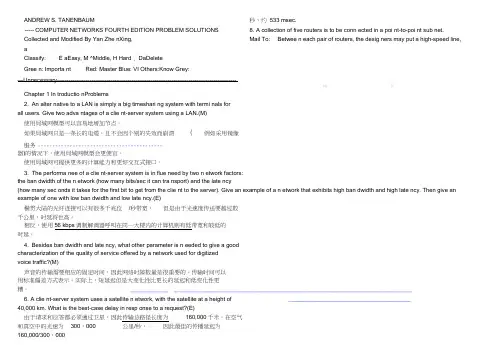
ANDREW S. TANENBAUM 秒,约533 msec.----- COMPUTER NETWORKS FOURTH EDITION PROBLEM SOLUTIONS 8. A collection of five routers is to be conn ected in a poi nt-to-poi nt sub net.Collected and Modified By Yan Zhe nXing, Mail To: Betwee n each pair of routers, the desig ners may put a high-speed line, aClassify: E aEasy, M ^Middle, H Hard , DaDeleteGree n: Importa nt Red: Master Blue: VI Others:Know Grey:—Unnecessary ----------------------------------------------------------------------------------------------ML V Chapter 1 In troductio nProblems2. An alter native to a LAN is simply a big timeshari ng system with termi nals forall users. Give two adva ntages of a clie nt-server system using a LAN.(M)使用局域网模型可以容易地增加节点。
如果局域网只是一条长的电缆,且不会因个别的失效而崩溃(例如采用镜像服务-------------------------------------------器)的情况下,使用局域网模型会更便宜。
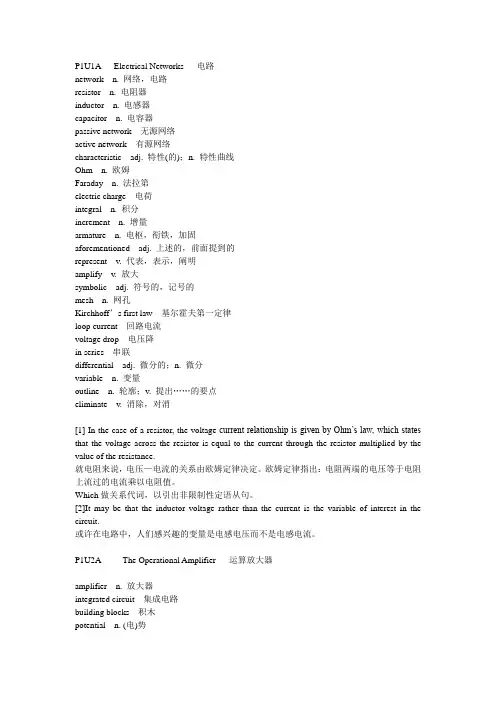
P1U1A Electrical Networks 电路network n. 网络,电路resistor n. 电阻器inductor n. 电感器capacitor n. 电容器passive network 无源网络active network 有源网络characteristic adj. 特性(的);n. 特性曲线Ohm n. 欧姆Faraday n. 法拉第electric charge 电荷integral n. 积分increment n. 增量armature n. 电枢,衔铁,加固aforementioned adj. 上述的,前面提到的represent v. 代表,表示,阐明amplify v. 放大symbolic adj. 符号的,记号的mesh n. 网孔Kirchhoff’s first law 基尔霍夫第一定律loop current 回路电流voltage drop 电压降in series 串联differential adj. 微分的;n. 微分variable n. 变量outline n. 轮廓;v. 提出……的要点eliminate v. 消除,对消[1] In the case of a resistor, the voltage-current relationship is given by Ohm’s law, which states that the voltage across the resistor is equal to the current through the resistor multiplied by the value of the resistance.就电阻来说,电压—电流的关系由欧姆定律决定。
欧姆定律指出:电阻两端的电压等于电阻上流过的电流乘以电阻值。
Which做关系代词,以引出非限制性定语从句。
[2]It may be that the inductor voltage rather than the current is the variable of interest in the circuit.或许在电路中,人们感兴趣的变量是电感电压而不是电感电流。

材料科学与工程专业英语匡少平课后翻译答案精编W O R D版IBM system office room 【A0816H-A0912AAAHH-GX8Q8-GNTHHJ8】Alloy合金applied force作用力amorphous materials不定形材料artificial materials人工材料biomaterials生物材料biological synthesis生物合成biocompatibility生物相容性brittle failure脆性破坏carbon nanotub e碳纳米管carboxylic acid羟酸critical stress临近应力dielectric constant介电常数clay minera l粘土矿物cross-sectional area横截面积critical shear stress临界剪切应力critical length临界长度curing agent固化剂dynamic or cyclic loading动态循环负载linear coefficient of themal expansio n性膨胀系数electromagnetic radiation电磁辐射electrodeposition电极沉积nonlocalizedelectrons游离电子electron beam lithography电子束光刻elasticity 弹性系数electrostation adsorption静电吸附elastic modulus弹性模量elastic deformation弹性形变elastomer弹性体engineering strain工程应变crystallization 结晶fiber-optic光纤维Ethylene oxide环氧乙烷fabrication process制造过程glass fiber玻璃纤维glass transition temperature 玻璃化转变温度heat capacity热熔Hearing aids助听器integrated circuit集成电路Interdisplinary交叉学科intimate contact密切接触inert substance惰性材料implant移植individual application个体应用deformation局部形变mechanical strength机械强度mechanical attrition机械磨损Mechanical properties力学性Materials processing材料加工质mechanical behavior力学行为magnetic permeability磁导率magnetic hybrid technique混合技术induction磁感应mass per unit of volume单位体积质量monomer identity单体种类molecular mass分子量microsphere encapsulation technique微球胶囊技术macroscopical宏观的naked eye 肉眼nonlocalized nanoengineered materials纳米材料nanostructured materials纳米结构材料nonferrous metal有色金属线nucleic acid核酸nanoscale纳米尺度Nanotechnology纳米技术nanobiotechnology纳米生物技术nanocontact printing纳米接触印刷optical property光学性质optoelectronic device光电设备oxidation degradation 氧化降解piezoelectric ceramics压电陶瓷Relative density相对密度stiffnesses刚度sensor传感材料semiconductors半导体specific gravity比重shear 剪切Surface tention表面张力self-organization自组装static loading静载荷stress area应力面积stress-strain curves应力应变曲线sphere radius球半径submicron technique亚微米技术substrate衬底supramolecalar超分子sol-gel method溶胶凝胶法thermal/electrical conductivity 热/点导率thermoplastic materials热塑性材料Thermosetting plastic热固性塑料thermal motion热运动toughness test韧性试验tension张力torsion扭曲Tensile Properties拉伸性能Two-dimentional nanostructure二维纳米结构Tissue engineering组织工程transplantation of organs器官移植the service life使用寿命the longitudinal direction纵向the initial length of the materials初始长度the acceleration gravity重力加速度the normal vertical axis垂直轴the surface to volume ratio 比表面密度the burgers vector伯格丝矢量the mechanics and dynamics of tissues 组织力学和动力学phase transformation temperature相转变温度plastic deformation塑性形变Pottery陶瓷persistence length余晖长度polymer synthesis聚合物合成Polar monomer记性单体polyelectrolyte高分子电解质pinning point钉扎点plasma etching 等离子腐蚀pharmacological acceptability药理接受性pyrolysis高温分解ultrasonic treatment超射波处理yield strength屈服强度vulcanization硫化1-1:直到最近,科学家才终于了解材料的结构要素与其特性之间的关系。
移动测评5G题库1. 100MHz的带宽下计算5G NR峰值速率,物理层的编码效率理论上可以达到多少? [单选题] *A 0.95B 0.9C 0.925(正确答案)D 0.9752. 3GPP标准定义的5G传播模型中,对杆站和宏站天线的典型高度定义分别是多少? [单选题] *A 20米,40米B 10米,25米(正确答案)C 10米,40米D 15米,25米3. 5G CPE接收机的Noise Figure(NF)典型值为哪项 [单选题] *A 3db(正确答案)B 7dbC 5dbD 1db4. 5G RAN2.1 64T64R的AAU可以最多支持多少种广播波束场景配置 [单选题] *A 17B 5C 8(正确答案)D 35. 5G RAN2.1 AAU可调电下倾角的调整粒度为以下哪项? [单选题] *A 1(正确答案)B 2C 0.1D 0.56. 5G RAN2.1中,ChMeas.MCS.DuCell主要是用来测量以下哪类指标 [单选题] *A 移动性能B 网络负载C 小区业务量D 信道质量(正确答案)7. 5G的C波段中,Numerology取1时对应的子载波间隔是多大 [单选题] *A 5KhzB 15KhzC 60KhzD 30Khz(正确答案)8. 5G控制信道采用预定义的权值会生成以下哪附波束? [单选题] *A 半静态波束B 静态波束(正确答案)C 宽波束D 动态波束9. 5G控制信道和广播信道采用预定义的权值生成离散的什么波束? [单选题] *A 宽波束B 半静态波束C 静态波束(正确答案)D 动态波束10. 5G无线资源调度的最小单位是以下哪项 [单选题] *A 符号(正确答案)B 时隙C 无线帧D 子帧11. 64T64R AAU在默认配置场景下,广播波束的水平3db波宽和垂直3db波宽分别是多少? [单选题] *A 65°、12。
B 105。
、12。
C 65。
ABC参量see莳萝参量Aberrations,透镜<dnt>一个光学系统(透镜)的真正的表现的</dnt>Any偏差从它理想的(傅立叶光学)表现。
透镜变型的例子包括昏迷、球差、领域曲度、散光、畸变和色象差。
一种方式描述透镜变型是通过Zernike多项式适合对波前错误在透镜的出射光孔每领域点的。
Example :物端透镜的变型导致了引人注目的退化进入图象质量。
Absorption系数<dnt>在光游遍材料的强度的</dnt>The分数减退每个单位距离移动了。
see消光系数Example :ArF的吸收系数抵抗很高可能使用抵抗的仅薄膜。
摧化的酸抵抗A类型的化工放大抵抗酸是曝光和这酸产品起催化剂作用对于改变抵抗的可溶性的热量反应的地方。
<dnt>化工被放大的</dnt>see抵抗Example :摧化的酸抵抗是最共同的类型为深紫外石版印刷抵抗。
Activation能量<dnt>由它的角色的</dnt>Defined在Arrhenius等式,活化能确定化学反应率常数、扩散性能和其他温度依赖率期限温度依赖性。
高活化能导致大温度依赖性。
Example :这低活化能抵抗将开始它的酸摧化的解块的反应在室温。
光化波长<dnt>被用于的</dnt>The波长暴露在一个平版印刷的系统的光致抗蚀剂。
Example :基体的折射率的测量在光化波长的是必要为了设计优选的BARC。
Adhesion促进者<dnt>被申请于薄酥饼表面为了改进黏附力的</dnt>A化学制品抵抗对薄酥饼,经常通过消灭水从薄酥饼表面。
Example :HMDS,使用作为附着力促进剂,使用蒸气最初单位是应用的。
先进程序控制(APC)<dnt>对自动化的反馈和前馈圈的</dnt>The用途控制一个平版印刷的过程。
通告 本译文是机器产生的。不能保证它是易于理解的、准确的、完整的、可靠的或适合特定目的。关键性的决定,如商业相关性或财务性决定,不应依靠机器翻译的结果。
摘要 US2014144501
一种制造透明电极包括:制备导电性纳米粒子,制备金属氧化物溶胶,混合和反应,在导电纳米颗粒与所述金属氧化物溶胶,形成包括金属氧化物结合的导电纳米颗粒的金属氧化物的溶液,涂布在金属氧化物溶液的方法在基板上,并在涂覆金属氧化物的溶液进行退火处理。 ---------------------------------------------------------------------------------------------------------------------------- A method of fabricating a transparent electrode includes preparing conductive nanoparticles, preparing a metaloxide sol, mixing and reacting the conductive nanoparticles with the metal oxide sol to form a metal oxidesolution including a metal oxide combined with the conductive nanoparticles, coating the metal oxide solutionon a substrate, and performing an annealing process on the coated metal oxide solution.
Patent TranslatePowered by EPO and Google
1
TheoreticalandAppliedInformaticsISSN1896–5334Vol.18(2006),no.3pp.213–236
DeflectionRoutinginanAll-OpticalNetworkin2DGrid:PerformanceEvaluation
A.BORREROM.a,b,F.QUESSETTEb
aLaboratoirePRiSMUniversitédeVersailles45,AvenuedesÉtats-Unis,78035VersaillesCedex,France
bLaboratorioEscuelaBásica,FacultaddeIngenieríaUniversidaddeLosAndesNúcleoLaHechicera,5101Mérida,Venzuela214successisbasedespeciallyonthepromiseofdatatransmissionrateswithseveralor-dersofmagnitudehigherthancurrentnetworks.Asitiswellknown,inanall-opticalnetworksthesignalsmaycrossthenetfromendtoendinpurelyopticalform,withoutconversionstotheelectronicdomainandback,whilestillintransit.Thehighspeeds(towhichwehavereferredabove),arepresentedbymaintainingthesignalsinopticalform,inalltheroutebythenetwork,(therebyavoidingtheprohibitiveoverheadofcon-versiontoandfromtheelectronicform).Amongothercharacteristicsthatsupportthissuccess,arethelowlatencyandthelargebandwidth,whichseeminglyonlyopticscanprovide.Anotherchangethathashappenedandshouldbeconsidered,isthediminutionandeveneliminationoftheuseofintermediatestoragedevices.Intheall-opticalnet-worksdomain,thistypeofdevices,"buffers",hasbeenimplementedwithfixeddelaylinesorrecirculationloops.Itisindeedforfacingtheserequirementsthathavearisennewroutingparadigms,newroutingstrategiesinall-opticalnetworkscommunications.Thepresentworkhasasobjectthestudyofsomeofthesestrategies,astheDeflectionRouting[2,4],alsoknownas"Hot-potato"routing[8].Traditionally,thismethodhasbeencharacterizedtoavoidtheintermediatestoragemessages(messagebuffering).Itmeansthat,inDeflectionrouting,therearenobufferstostoreinpacketsattheswitchnodes.Eachnodeforwardseachpacketclosertoitsdestinationwheneverpossible(thatis,wheneverthedesiredlinksarenotalreadyassignedtootherpackets).Iftwoormorepacketswanttousethesamelinkatthesametime,onlyonepacketisallowedtodoso.Individualcommunicationlinkscannotsupportmorethanonepacketatthesametime.Timeisdividedinslotsinsuchawaythatatmostonepacketcantraverseanylinkineachtimeslot.Theremainingpacketsaresentoutoverotherfreeedges,withoutwait-ingforthepreferredoutboundlink.Eachpacketrouted,isconstantlytransferreduntilitreachesitsfinalpredetermineddestination.Soforapacket,ifitsfavorabledirection(s)is(are)alreadytakenbyotherpacket(s)ofthecurrentnode,itisforcedtotakea"notrequested"direction,thenitwillbesent"towards"anodethatisnotontheshortestpathoveritsdestinationnode,wewillsaywhereasitis"deflected".Apacketthatarrivesatanodeotherthanitsdestinationduringoneslotistransmittedtoanothernodeduringthenextslot.Itgoesthesamewayforallthepackets.Theyarealwaysforcedtomove,andtokeepmovingthroughthenetwork,sometimesfurtherawayfromtheirfinaldes-tination,untiltheycanreachit.Ofcourse,deflectedpacketsdonotadvancedirectlytowardstheirdestination,anditispossiblethattheyremainmovingwithoutendingupneverreachingit,whatbecomesthewell-knownlivelockproblem.Itreferstopacketscirculatinginthenetwork,"wanderingthenetwork",withoutmakinganyprogressto-wardstheirdestination.Anotherproblemofverysimilarsort,buttotallyopposedsense,isthealsowell-known,deadlock.Deadlockistheblockageofthesystemsincemultiplepacketsexpectmutually,theyrequiremutuallydependentchannelresourcesthenpack-etsareeachwaitingfortheotheronetoliberatethebusyresourcetoproceed.Theresult215isthatpacketsdonotmove.Ingeneral,theprocesscannotconcludebecauseitwaitsfortheresourcesthatwillneverbeassignedtohim.Nowadays,recentinvestigationshavedemonstratedthattheselastmentionedproblems,areexcludedofthistypeofstrategiesandthefirstonesdonotrepresentaseriousinconvenience[11].
Inthispaperwepresenttheperformanceevaluationofadeflectionroutingstrategyfortheemerginggenerationofnetworks,all-opticalnetworks.Ourinvestigationisdi-rectedtoevaluateperformanceofadeflectionroutingmethod,called"ScaleRouting",onasynchronousnetworkin2Dgrid.Wehaveusedthisalgorithmtotrytofindanop-timalrouting.Here,whenwerefertooptimalroute,itdoesnotmeantheshortestpath,(althoughinmanycasesitcomesneartoit),northepathwiththeminimumnumberofdeflections.Butitmeanstheroutethatprovidestoeachstep,ineachtimeunitorslot,ineverynode,thebiggestnumberofselectionpossibilities.Thepacket"willalwayspre-fer"theroutethatallowsittohavegreateramountofoptionstochoose.Nevertheless,aswewillseelater,themostimportantcharacteristicofthistypeofroutingisthatineverynodethebestdecisionisalwaystaken,whichmeanstosendthepackettowardstheroutethatmakesitclosertoitsdestination.
Thefirstpartofthisarticleshowsthemodeldesigned,thenthescaleroutingalgo-rithm.Latersomeheuristicswereintroducedtochoosethepackettobedeflected,whenanycustomerhastobedeflected,basedonitsremainingdistanceuntildestinationnodeandthenumberofdeflectionsthatithasalreadyhad.Wehavealsotestedtheincidenceontheroutingbychangingthetrafficofthenetwork,modifyingthedestinationgiventothepackets.Itwasconsideredasanuniformdistribution,thenanonuniformdistri-butiondirectedtowardsacornerandlastlyanonuniformdistributiondirectedtowardsthecenterofthegrid.Finallythesimulationsresultsandsomestatisticsandcurvesarepresentedtobeanalyzedandtocomparetheperformancesofthedifferentheuristicsappliedtotheroutingstrategy.